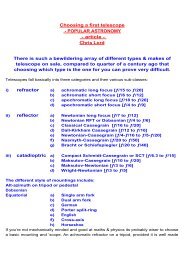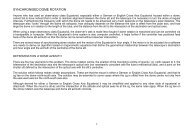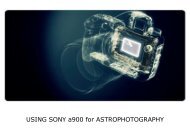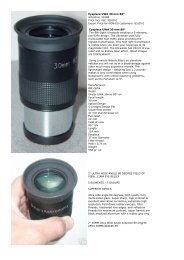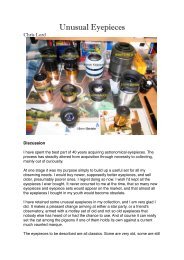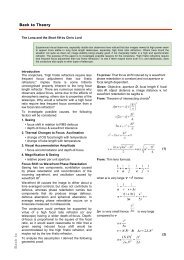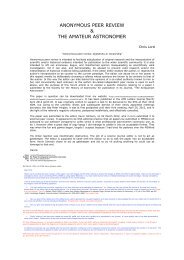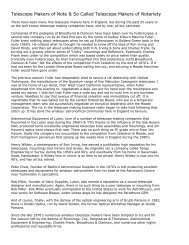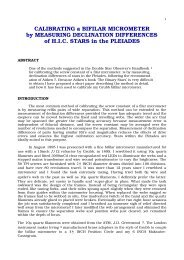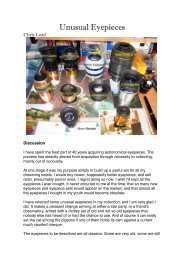Evolution of the Astronomical Eyepiece - Brayebrook Observatory
Evolution of the Astronomical Eyepiece - Brayebrook Observatory
Evolution of the Astronomical Eyepiece - Brayebrook Observatory
You also want an ePaper? Increase the reach of your titles
YUMPU automatically turns print PDFs into web optimized ePapers that Google loves.
TESTING EYEPIECES (cont.):<br />
EVOLUTION <strong>of</strong> <strong>the</strong> ASTRONOMICAL EYEPIECE<br />
Is it in focus or diffuse How objectionable<br />
ghosting is depends to a large<br />
extent on <strong>the</strong> type <strong>of</strong> observing you do.<br />
An eyepiece that produces bright on<br />
axis ghosts that ei<strong>the</strong>r follow or mirror<br />
<strong>the</strong> image would not be a nuisance if<br />
you are observing M32 say, but would<br />
be when observing M13. Likewise a diffuse<br />
<strong>of</strong>f axis ghost that follows <strong>the</strong><br />
image might cause confusion when<br />
comet hunting.<br />
vii) Lateral colour is easy to detect,<br />
and almost all eyepieces exhibit it,<br />
some more so than o<strong>the</strong>rs. It is also<br />
more obvious with fast objectives. As<br />
<strong>the</strong> star image is displaced towards <strong>the</strong><br />
edge <strong>of</strong> <strong>the</strong> field, it becomes drawn out<br />
into a short spectra, red towards <strong>the</strong><br />
c e n t re when underc o r rected, blue<br />
when overcorrected. The eye is remarkably<br />
tolerant <strong>of</strong> this malady, especially<br />
w hen using wide angle eyepieces,<br />
where it is worst, because, when <strong>the</strong><br />
eye is fixated on axis, <strong>the</strong> <strong>of</strong>f axis image<br />
towards <strong>the</strong> edge <strong>of</strong> field falls on <strong>the</strong><br />
portion <strong>of</strong> <strong>the</strong> retina which is capable<br />
<strong>of</strong> only giving black and white images!<br />
Also faint stars exhibit no sensible<br />
colour in any case, masking <strong>the</strong> aberration<br />
somewhat.<br />
viii) Astigmatism, due mainly to <strong>the</strong><br />
eyepiece, and coma, due mainly to <strong>the</strong><br />
objective <strong>of</strong> a reflector, are never seen<br />
in isolation. Any star, when displaced<br />
towards <strong>the</strong> edge <strong>of</strong> field will become<br />
ei<strong>the</strong>r elongated or triangular or fan<br />
shaped, apex inner most. When <strong>the</strong> eye<br />
is fixated on axis, astigmatism and<br />
coma need to be very marked for <strong>the</strong><br />
eye to resolve it. It is only when <strong>the</strong> eye<br />
is fixated towards <strong>the</strong> field boundary<br />
that <strong>the</strong>se aberrations become obvious.<br />
However no eyepiece is completely free<br />
<strong>of</strong> it. The wider <strong>the</strong> apparent field and<br />
<strong>the</strong> faster <strong>the</strong> objective, <strong>the</strong> worse it<br />
becomes.<br />
ix) Field curvature can easily be<br />
tested too. Focus <strong>the</strong> star on axis and<br />
displace it to <strong>the</strong> field edge. Does <strong>the</strong><br />
image defocus If you need to rack <strong>the</strong><br />
eyepiece towards <strong>the</strong> objective <strong>the</strong>n <strong>the</strong><br />
focal surface is convex towards <strong>the</strong> eye<br />
and vice versa. The eye is remarkably<br />
tolerant <strong>of</strong> field curvature, especially<br />
in <strong>the</strong> young, because you unconsciously<br />
accommodate as you shi ft<br />
your dir ection <strong>of</strong> fixation. As <strong>the</strong> range<br />
in visual accommodation diminishes<br />
with advancing old age field curvature<br />
becomes a problem. And <strong>the</strong> wider <strong>the</strong><br />
apparent field and <strong>the</strong> faster <strong>the</strong> objective,<br />
<strong>the</strong> bigger <strong>the</strong> problem becomes.<br />
x) Distortion is difficult to detect<br />
visually except when <strong>the</strong> coefficient<br />
exceeds 20%, and only <strong>the</strong>n on bright<br />
extended objects containing rectilinear<br />
or regularly spaced features.<br />
xi) Contrast and transmission, go<br />
hand in glove. Image contrast may be<br />
tested by comparing <strong>the</strong> appearance <strong>of</strong><br />
<strong>the</strong> outermost visible diffraction rings<br />
to <strong>the</strong> Airy disc, or <strong>the</strong> faintest visible<br />
detail on a planet. Transmission may<br />
be tested by seeing how difficult it is to<br />
detect <strong>the</strong> faint companions <strong>of</strong> very<br />
bright stars, e.g. Vega or Rigel or<br />
Regulus. The darkness <strong>of</strong> <strong>the</strong> field<br />
background is also an important indicator.<br />
Contrast and transmission are<br />
<strong>the</strong> most important properties <strong>of</strong> any<br />
eyepiece, being crucial to good definition.<br />
46



